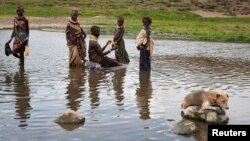Initial tests on a vast aquifer found in Kenya's drought-wracked Turkana region show the water is too salty to drink.
The 2013 discovery of underground lakes in Kenya’s arid region in Turkana brought hope to some of the 135,000 people in need of food assistance there.
Satellite imagery show the two aquifers were the size of the U.S. state of Delaware.
Two years later, hope is quickly fading as the first test results from Lotikipi - the largest aquifer which is close to Kenya's border with South Sudan - show the water is too salty to drink.
After drilling 350 meters underground, saline levels are seven times higher than considered safe by the World Health Organization (WHO).
But Jackson Edung, a water officer in Turkana, noted that the report did not tell the whole story, because some adjoining wells were within acceptable saline limits and could help alleviate the problems of the arid region.
"That’s a negative report. That water, it has no alkalinity. In fact the alkalinity of that water is less than seven and that water can be used for agriculture and livestock. In fact in most cases around that borehole there other more wells that can be found and there’s no salinity," he said.
Kenya’s northern region is susceptible to recurrent drought which decimates livestock kept by the traditional nomadic herders. The statistics paint a grim picture. With an estimated population of 135,000, one in four people require food assistance.
Armed conflict over resources between the Pokot and Turkana communities further exacerbates an already dire situation.
Although cattle rustling is deeply rooted in the pastoral culture, raids have turned deadly since the herding communities became heavily armed, mostly with weapons inherited from the Sudanese and Ugandan wars, but also with rifles procured and misused by reservists in the Kenyan police.
With greater pressure on fewer resources, the consequences have been particularly dire for pastoralists, who make up 60 percent of the population in Turkana district. Malnutrition rates are above the emergency level of 15 percent.
Experts here are still hopeful that other wells could provide the answer to perennial water problems. Water Engineer Njoroge Ngare told VOA that a desalination program was the key.
“It is very viable. What you do is you just desalinate water for human consumption, but water for other uses you don’t desalinate you use it as it is. And therefore it is very possible. Already as we are speaking there are organizations who are desalinating water from the rift valley which ordinarily has very high levels of Flouride. It is a bit expensive but it is cheaper than tracking water to those communities,” said Ngare.
A stable water supply from the 250 billion cubic meters of water thought to be in Turkana's underground lakes could help mitigate these recurring hunger crises. More than a third of Kenya's 41 million people have no access to clean water.











